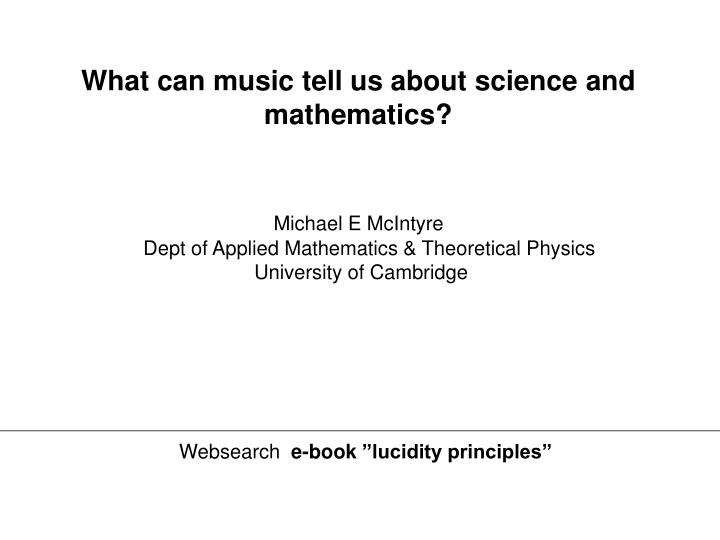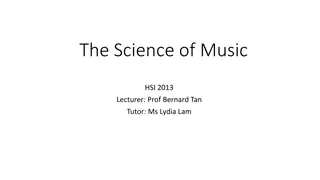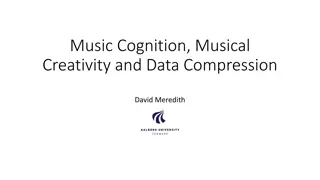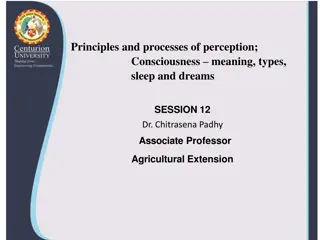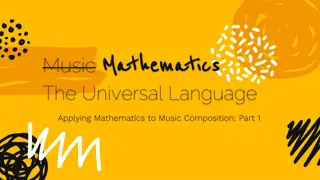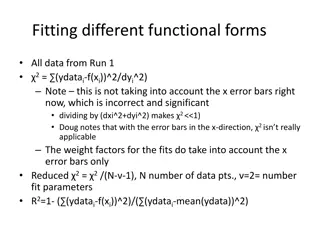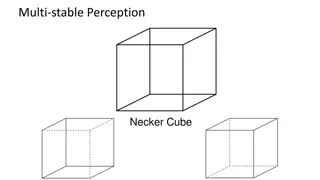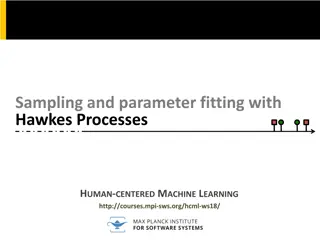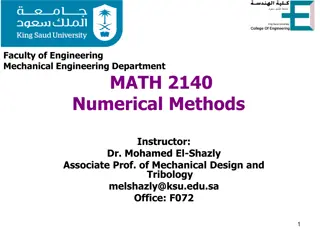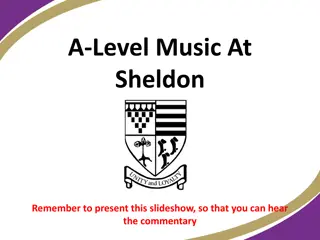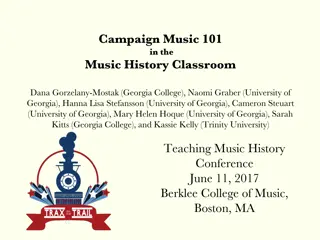The Intersection of Music, Science, and Mathematics: Insights on Perception and Model-Fitting
Exploring the relationship between music, science, and mathematics reveals profound connections in understanding perception through model-fitting. An intriguing idea suggests that the unconscious brain fits internal models to sensory data, shaping our perceived reality. This concept has far-reaching implications and can be illustrated by phenomena like the walking lights.
Download Presentation

Please find below an Image/Link to download the presentation.
The content on the website is provided AS IS for your information and personal use only. It may not be sold, licensed, or shared on other websites without obtaining consent from the author.If you encounter any issues during the download, it is possible that the publisher has removed the file from their server.
You are allowed to download the files provided on this website for personal or commercial use, subject to the condition that they are used lawfully. All files are the property of their respective owners.
The content on the website is provided AS IS for your information and personal use only. It may not be sold, licensed, or shared on other websites without obtaining consent from the author.
E N D
Presentation Transcript
What can music tell us about science and mathematics? Michael E McIntyre Dept of Applied Mathematics & Theoretical Physics University of Cambridge Websearch e-book lucidity principles
What can music tell us about science and mathematics? What indeed is music? What is science? What is mathematics? Websearch e-book lucidity principles
What can music tell us about science and mathematics? What indeed is music? What is science? What is mathematics? How did our ancestors survive? Websearch e-book lucidity principles
What can music tell us about science and mathematics? What indeed is music? What is science? What is mathematics? How did our ancestors survive? How does perception work? Websearch e-book lucidity principles
An idea to take seriously (with far-reaching implications): perception works by model-fitting. Websearch e-book lucidity principles
An idea to take seriously (with far-reaching implications): perception works by model-fitting. The unconscious brain actively fits an internal model to the sensory data coming in from the outside world. Websearch e-book lucidity principles
An idea to take seriously (with far-reaching implications): perception works by model-fitting. The unconscious brain actively fits an internal model to the sensory data coming in from the outside world. If the fit is good enough, the internal model becomes the perceived reality. Websearch e-book lucidity principles
An idea to take seriously (with far-reaching implications): perception works by model-fitting. The unconscious brain actively fits an internal model to the sensory data coming in from the outside world. If the fit is good enough, the internal model becomes the perceived reality. Example: the walking lights : Websearch e-book lucidity principles
And what is a model? Websearch e-book lucidity principles
And what is a model? (in the sense used here a very general sense) Websearch e-book lucidity principles
And what is a model? (in the sense used here a very general sense) Answer: a partial and approximate representation of reality (e.g. of a real person really walking) Websearch e-book lucidity principles
And what is a model? (in the sense used here a very general sense) Answer: a partial and approximate representation of reality (e.g. of a real person really walking) NB: Science works the same way. Websearch e-book lucidity principles
And what is a model? (in the sense used here a very general sense) Answer: a partial and approximate representation of reality (e.g. of a real person really walking) NB: Science works the same way. (e.g. Einstein s theory of gravity) Websearch e-book lucidity principles
And what is a model? (in the sense used here a very general sense) Answer: a partial and approximate representation of reality (e.g. of a real person really walking) NB: Science works the same way. (e.g. Einstein s theory of gravity) (Implication: science is not about Absolute Truth or Absolute Proof.) Websearch e-book lucidity principles
And what is a model? (in the sense used here a very general sense) Answer: a partial and approximate representation of reality (e.g. of a real person really walking) NB: Science works the same way. (e.g. Einstein s theory of gravity) (Implication: science is not about Absolute Truth or Absolute Proof.) (For one thing, we must assumethat there s an outside world ) Websearch e-book lucidity principles
Models and model-fitting require mathematics Websearch e-book lucidity principles
Models and model-fitting require mathematics (e.g. Euclidean geometry). Websearch e-book lucidity principles
Models and model-fitting require mathematics (e.g. Euclidean geometry). Implication: we all have unconscious mathematics. Websearch e-book lucidity principles
Models and model-fitting require mathematics (e.g. Euclidean geometry). Implication: we all have unconscious mathematics. Another way to say it is: We all have an unconscious power of abstraction Websearch e-book lucidity principles
Models and model-fitting require mathematics (e.g. Euclidean geometry). Implication: we all have unconscious mathematics. Another way to say it is: We all have an unconscious power of abstraction and what is abstraction? Answer: the ability to handle many possibilities at once Websearch e-book lucidity principles
Models and model-fitting require mathematics (e.g. Euclidean geometry). Implication: we all have unconscious mathematics. Another way to say it is: We all have an unconscious power of abstraction and what is abstraction? Answer: the ability to handle many possibilities at once (even an infinite number of possibilities). Websearch e-book lucidity principles
All this can be seen as a consequence of biological natural selection Websearch e-book lucidity principles
All this can be seen as a consequence of biological natural selection along with certain mathematical facts, especially combinatorial largeness. Websearch e-book lucidity principles
All this can be seen as a consequence of biological natural selection along with certain mathematical facts, especially combinatorial largeness. The unconscious brain must choose the model components to fit to the incoming data from a combinatorially large number of possibilities. Websearch e-book lucidity principles
So, internal-model components need to be as simple as possible: (Platonic objects elegance computational economy) Websearch e-book lucidity principles
So, internal-model components need to be as simple as possible: (Platonic objects elegance computational economy) Websearch e-book lucidity principles
So, internal-model components need to be as simple as possible: (Platonic objects elegance computational economy) Perfectly smooth curves are what we perceive when the data allow it. Websearch e-book lucidity principles
So, internal-model components need to be as simple as possible: (Platonic objects elegance computational economy) Perfectly smooth curves are what we perceive when the data allow it. Websearch e-book lucidity principles
So, internal-model components need to be as simple as possible: (Platonic objects elegance computational economy) Perfectly smooth curves are what we perceive when the data allow it. A perfectly straight line is another Platonic object: Websearch e-book lucidity principles
So, internal-model components need to be as simple as possible: (Platonic objects elegance computational economy) Perfectly smooth curves are what we perceive when the data allow it. A perfectly straight line is another Platonic object: Websearch e-book lucidity principles
So, internal-model components need to be as simple as possible: (Platonic objects elegance computational economy) There are many more Platonic objects. E.g. an infinitely large number of smooth curves. Websearch e-book lucidity principles
So, internal-model components need to be as simple as possible: (Platonic objects elegance computational economy) There are many more Platonic objects. E.g. an infinitely large number of smooth curves. Here s another smooth curve can you see it? Websearch e-book lucidity principles
So, internal-model components need to be as simple as possible: (Platonic objects elegance computational economy) There are many more Platonic objects. E.g. an infinitely large number of smooth curves. Here s another smooth curve can you see it? (unconscious mathematics again) Websearch e-book lucidity principles
Model-fitting takes place in spacetime. (The walking lights demonstrate it, as does any other movie.) (unconscious mathematics again) Websearch e-book lucidity principles
Model-fitting takes place in spacetime. (The walking lights demonstrate it, as does any other movie.) We can perceive continuous motion despite actual discontinuities. (unconscious mathematics again) Websearch e-book lucidity principles
Model-fitting takes place in spacetime. (The walking lights demonstrate it, as does any other movie.) We can perceive continuous motion despite actual discontinuities. Musical example: Mozart s flowing oil a feeling of continuous motion evoked by discontinuous sounds(from the K545 piano sonata). (unconscious mathematics again) Websearch e-book lucidity principles
Music takes us deeper still. Websearch e-book lucidity principles
Music takes us deeper still. Natural selection again: auditory scene analysis. Websearch e-book lucidity principles
Music takes us deeper still. Natural selection again: auditory scene analysis. An implication is that the harmonic series is another Platonic object, part of the brain s model-building repertoire Websearch e-book lucidity principles
Music takes us deeper still. Natural selection again: auditory scene analysis. An implication is that the harmonic series is another Platonic object, part of the brain s model-building repertoire Websearch e-book lucidity principles
Music takes us deeper still. Natural selection again: auditory scene analysis. An implication is that the harmonic series is another Platonic object, part of the brain s model-building repertoire (cross-cultural indeed cross-species) Websearch e-book lucidity principles
Music takes us deeper still. Natural selection again: auditory scene analysis. An implication is that the harmonic series is another Platonic object, part of the brain s model-building repertoire (cross-cultural indeed cross-species) Websearch e-book lucidity principles
Music takes us deeper still. Natural selection again: auditory scene analysis. An implication is that the harmonic series is another Platonic object, part of the brain s model-building repertoire (cross-cultural indeed cross-species) Websearch e-book lucidity principles
Music takes us deeper still. Natural selection again: auditory scene analysis. An implication is that the harmonic series is another Platonic object, part of the brain s model-building repertoire (cross-cultural indeed cross-species) Websearch e-book lucidity principles
Music takes us deeper still. Natural selection again: auditory scene analysis. An implication is that the harmonic series is another Platonic object, part of the brain s model-building repertoire (cross-cultural indeed cross-species) Websearch e-book lucidity principles
Music takes us deeper still. Natural selection again: auditory scene analysis. An implication is that the harmonic series is another Platonic object, part of the brain s model-building repertoire (cross-cultural indeed cross-species) Websearch e-book lucidity principles
Music takes us deeper still. Natural selection again: auditory scene analysis. An implication is that the harmonic series is another Platonic object, part of the brain s model-building repertoire (cross-cultural indeed cross-species) Websearch e-book lucidity principles
Music takes us deeper still. Natural selection again: auditory scene analysis. An implication is that the harmonic series is another Platonic object, part of the brain s model-building repertoire (cross-cultural indeed cross-species) Websearch e-book lucidity principles
Tui song recorded in Invercargill, New Zealand: > Recording by Les McPherson Websearch e-book lucidity principles
Also basic to our perceptual and cognitive processes: the organic-change principle: The unconscious brain is interested in and likes to play with patterns in which some things change slightly, while others stay the same. (Another abstract idea.) And it takes us from juvenile play toward some of the deepest connections between music and mathematics. Websearch e-book lucidity principles
